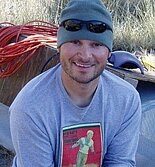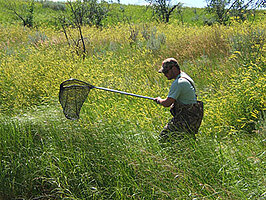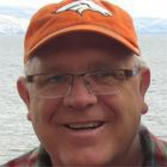Integrating life state habitat into landscape genetics model for the conservation of a declining amphibians species

Justin Fisher is a graduate student (Ph.D.) in the Environmental & Conservation Sciences (ECS) Graduate Program at NDSU. Justin completed his B.S. in zoology emphasizing in fisheries, wildlife, ecology, and behavior from NDSU in May of 2007. Justin's main research focuses on evaluating the genetic diversity and structure of northern leopard frogs (Rana pipiens) throughout the state of North Dakota.
Justin.D.Fisher@my.ndsu.edu
Fellow: Justin Fisher
Advisor: Dr. Craig Stockwell, Department of Biological Sciences
Degree Progress:Ph.D. in Environmental & Conservation Sciences expected graduation 2014
Integrating life state habitat into landscape genetics model for the conservation of a declining amphibians species
What was once thought to be a highly abundant amphibian throughout much of North America, the northern leopard frog (Rana pipiens) has been recently petitioned for federal protection. Research and monitoring programs indicate widespread population declines and the U.S. Fish & Wildlife Service is currently seeking species information, particularly on genetic health. The northern leopard frog is unique compared to other amphibians in North Dakota in the fact that it behaviorally evades harsh winter weather by over-wintering in available wetlands at the water/mud interface. However, this over-wintering strategy can be deadly if freezing temperatures (i.e., ice) extend to the wetland bottom. Therefore, northern leopard frogs require wetlands with deep water, to survive winter. However, during severe drought events in North Dakota, such drought refugia become uncommon. Thus, the spatial and temporal distribution of drought refugia can play an important role in the distribution of northern leopard frogs on the landscape. Accordingly, understanding where populations persist during past climate extremes can be used to provide insights into the role of drought refugia in northern leopard frog population dynamics, particularly in terms of genetic diversity and gene flow across the landscape.
Background:
What was once thought to be a highly abundant amphibian throughout much of North America, the northern leopard frog (Lithobates pipiens) has been recently petitioned for federal protection. Research and monitoring programs indicate widespread population declines and the U.S. Fish & Wildlife Service is currently seeking species information, particularly on genetic health. The northern leopard frog is unique compared to other amphibians in North Dakota in the fact that it behaviorally evades harsh winter weather by over-wintering in available wetlands at the water/mud interface. However, this over-wintering strategy can be deadly if freezing temperatures (i.e., ice) extend to the wetland bottom. Therefore, northern leopard frogs require wetlands with deep water, to survive winter. However, during severe drought events in North Dakota, such drought refugia become uncommon. Thus, the spatial and temporal distribution of drought refugia can play an important role in the distribution of northern leopard frogs on the landscape. Accordingly, understanding where populations persist during past climate extremes can be used to provide insights into the role of drought refugia in northern leopard frog population dynamics, particularly in terms of genetic diversity and gene flow across the landscape.
Project Objectives:
The study I propose is designed to develop a landscape genetics model by integrating genetic surveys of populations occurring at known long-term overwintering sites with environmental and landscape variables. This work will involve three objectives:
- Examine population genetic structures at drought refugia sites to understand genetic sources for potential re-colonization of northern leopard frog populations in ND
- Develop landscape genetic models to evaluate current influences of gene flow on northern leopard frog populations in ND
Progress:
Throughout the 2012 funding period, I was able to focus my efforts on laboratory sample processing and data analysis. Specifically, I DNA and amplified 11 microsatellite markers via PCR (polymerase chain reaction) on an additional 12 populations of L. pipiens. This work, combined with my previous data gathered, increased my sample size up to 31 populations (930 total individuals). In addition to my lab work, I was also able to thoroughly analyze my genetic data and begin building landscape genetic models using a model selection approach. My results indicate that populations are structured throughout North Dakota and that we see isolation by distance among pair-wise population comparisons. Additionally, my results indicate a strong east to west trend of decreases in population genetic measures including expected heterozygosity, allelic richness, and effective population size. When I extract radial landscape attributes in a geographical information system (GIS), I find that a model selection approach reveals that the number of permanent wetlands (i.e., draught refugia) and percentage of grassland carry the relative model weights and are considered the top models using Akaike’s Information Criterion adjusted for small sample size (AICc). These results have been presented at four different meetings resulting in two best student paper presentations.
Significance:
My proposed research is very timely due to the recent proposed listing of the northern leopard frog. Managers are seeking genetic data to help identify regions/populations that should be included in the listing. By incorporating GIS models, I will be able to predict how geographic and environmental variables influence the spatial and temporal distribution of northern leopard frog populations. For instance, limited genetic variability and high structure is expected for isolated populations found in regions where distinctly separate overwintering wetlands occur, such as the southwestern part of the state. This research extends standard landscape genetic models to incorporate important spatial and temporal distribution of drought refugia sites to produce more robust models needed to understand long-term population structure of northern leopard frogs. This research will contribute valuable insights for state and federal managers as they consider the petition for listing the northern leopard frog under the Endangered Species Act.
Publications:
Fisher, J., K. Purcell and C. Stockwell. Initial Survey of the Genetic Diversity of Northern Leopard Frog Populations in North Dakota. North Dakota Chapter of the Wildlife Society Annual Meeting, Mandan, ND, 02/2011.
Fisher, J., K. Purcell and C. Stockwell. Survey of the Genetic Diversity of Northern Leopard Frog Populations in North Dakota. Joint Meeting of Ichthyologists and Herpetologists, Minneapolis, MN, 07/2011
Fisher, J., K. Purcell and C. Stockwell. Survey of the Genetic Diversity of Northern Leopard Frog Populations in North Dakota. NDSU Environmental & Conservation Sciences Graduate Student Poster Competition, Fargo, ND, 10/2011
Fisher, J., K. Purcell and C. Stockwell. Survey of the Genetic Diversity of Northern Leopard Frog Populations in North Dakota. Joint Annual Meeting of the Minnesota & North Dakota Chapters of The Wildlife Society, Fargo, ND, 02/2012 **Best Student Paper Award
Fisher, J., K. Purcell and C. Stockwell. Genetic Diversity of the Northern Leopard Frog Across the 100th Meridian. 9th Annual Northern Plains Biological Symposium, Fargo, ND, 04/2012
Fisher, J., K. Purcell and C. Stockwell. Genetic Diversity of the Northern Leopard Frog Across the 100th Meridian. Society for Conservation Biology – North American Congress for Conservation Biology, Oakland, CA, 07/2012
Fisher, J., K. Purcell and C. Stockwell. Landscape Influences on Effective Population Size of Northern Leopard Frog Populations in North Dakota. 50th Annual Meeting of the North Dakota Chapter of The Wildlife Society, Mandan, ND, 02/2013 **Best Student Paper Award


Craig Stockwell
Biological Sciences
Office: Stevens 119
Telephone: 701-231-8449
Email: craig.stockwell@ndsu.edu


